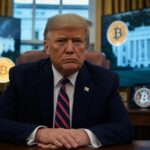Now Reading: Where Do President Trump’s Trade Proposals Stand?
-
01
Where Do President Trump’s Trade Proposals Stand?
Where Do President Trump’s Trade Proposals Stand?
:max_bytes(150000):strip_icc()/GettyImages-2206617324-3c567d54c5be45a28d409a7c39f4a458.jpg?w=1920&resize=1920,1267&ssl=1)
:max_bytes(150000):strip_icc():format(jpeg)/GettyImages-2206617324-3c567d54c5be45a28d409a7c39f4a458.jpg)
President Donald Trump has imposed tariffs on U.S. trading partners and promised that many more will be implemented. A number of new tariffs are due to go into effect on April 2, which the president refers to as “Liberation Day.”
The tariffs, a cornerstone of Trump’s economic plan, have ever-changing parameters and deadlines. Some tariffs have been used as bargaining chips with other countries, while others are designed to bring manufacturing and jobs back to the U.S. They are also a way the president plans to offset some of the government’s spending.
However, Trump’s on-again, off-again approach to tariff policy has created uncertainty in the economy. Businesses and consumers alike worry that inflation will rise and that the economy could be headed toward a recession, and that uncertainty has weighed on investor sentiment, sending stocks sharply lower in recent months.
Read More
Want to know more about the broad implications of all these tariffs? Here are some of our latest headlines about how trade policies are affecting the economy and financial markets.
Investopedia has worked to gather all of Trump’s tariff proposals. Only those with some level of detail (either the proposed rate or the date it is to be enacted) and documentation are included. This page will be updated regularly as parameters change or more information becomes available.
Tariffs on Countries
A Closer Look
Mexico: President Donald Trump announced trade policies on Mexico before he even took office. Since then, the policy toward our neighbors to the south has changed a number of times.
In the latest move, Trump taxed all items from Mexico at a flat 25% rate but then quickly made exceptions for USMCA goods. Those exceptions cover a bulk of what would be taxed, but Trump has said the exemptions are only temporary and will be lifted on April 2.
Canada: Canada has largely shared Mexico’s plight under Trump’s trade policies but has sometimes faced additional tariffs as Ottawa has hit back. Any non-USMCA items from Canada are taxed at a 25% rate, but that could change on April 2, the president said. Energy resources and potash were later included in tariffs on our northern neighbors and taxed at 10%. More tariffs on the country, such as on dairy and lumber products, could also be enacted on April 2.
Venezuela: While the Venezuelan taxes are geared toward the South American country, they will actually be implemented on others. The 25% tariff will be imposed on goods imported into the U.S. from countries that buy Venezuelan oil. This could include China, the Dominican Republic, India, Malaysia, Russia, Singapore, Spain, and Vietnam.
Oil accounts for more than 80% of Venezuela’s exports and more than 17% of its gross domestic product (GDP), and these tariffs are intended to affect the country’s economy. Trump has targeted Venezuela because he says it is “an unusual and extraordinary threat to the national security and foreign policy of the United States.”
Tariffs on Items, Sectors or Industries
A Closer Look
Reciprocal: If it were to go through as planned, reciprocal tariffs would be the most widespread trade policy thus far. Under this proposal, the U.S. would mirror the tariffs imposed on U.S. exports of that country’s goods. For example, if items from the U.S. were taxed at a 5% rate when they were sent to the U.K., items from the U.K. would be taxed at 5% as they came into the U.S.
However, Trump has already walked back some of his original promises, saying he would be lenient on “a lot of countries.” It’s still unclear whether the reciprocal taxes would be a flat rate for an entire country or imposed on an item-by-item basis. These tariffs are set to kick in on April 2, so more information may be available then.
Automobiles: In his attempt to bring manufacturing back to the U.S., Trump is building a wall around U.S. automaking. The import tax on cars outside of the country will be permanent, and engines, transmissions, electrical components, and other parts are expected to be included. Parts that have been exempt under other tariff proposals that are included in the USMCA have a reprieve here, but it could be temporary, analysts said.
It’s unclear whether this manufacturing play will work. U.S. labor is still more costly than that of other countries. Analysts said that for many companies, it could still be cheaper to pay the tariff than to move vehicle manufacturing operations.
Pharmaceuticals: Trump has mentioned pharmaceutical tariffs in a number of press conferences but has not laid out any specific plans beyond the comments. At one point, Trump said import taxes on medications could be a tax of 25% or higher and could increase over a year to give companies an on-ramp. Prescription drug prices have been a particular area of concern for voters, but like with most tariffs, this could push up the price for those medications.













:max_bytes(150000):strip_icc()/WarrenBuffet1-13bb5491733149e8b1c61de425c56eaa.jpg?w=1024&resize=1024,1024&ssl=1)
:max_bytes(150000):strip_icc()/GettyImages-2211161340-f1316328b5eb48938eb3e9edccc29f68.jpg?w=1024&resize=1024,1024&ssl=1)
:max_bytes(150000):strip_icc()/GettyImages-2198719159-32ed40e8133f46189f8f13340d3d84c5.jpg?w=1024&resize=1024,1024&ssl=1)











:max_bytes(150000):strip_icc()/WarrenBuffet1-13bb5491733149e8b1c61de425c56eaa.jpg?w=150&resize=150,150&ssl=1)